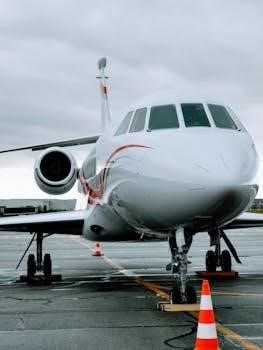
asa private pilot oral exam guide
The Private Pilot Oral Exam is a crucial part of the FAA checkride. It tests a student pilot’s knowledge of aviation principles. This guide helps prepare candidates for this exam using a Q&A approach.
Purpose of the Oral Exam
The primary purpose of the Private Pilot Oral Exam is to rigorously assess a candidate’s understanding of aviation knowledge, ensuring they possess the necessary theoretical foundation for safe and competent flight operations. This exam, a key component of the FAA checkride, goes beyond simple memorization, probing into the depth of a student pilot’s grasp of regulations, aircraft systems, weather, and emergency procedures. It aims to verify that the applicant can not only recite facts but can also apply this knowledge in practical, real-world scenarios. The oral exam also serves as an opportunity for the examiner to gauge the applicant’s critical thinking and decision-making skills, essential qualities for a responsible pilot; Furthermore, it ensures the pilot understands the limitations of their private pilot certificate, focusing on safety and compliance. This comprehensive assessment is vital in upholding the high standards of aviation safety and proficiency.
Importance of Preparation
Thorough preparation for the Private Pilot Oral Exam is absolutely critical for success and for ensuring a safe flying career. The exam tests not just rote memorization but also the ability to apply knowledge in practical situations. Adequate preparation builds confidence, reduces anxiety, and allows pilots to showcase their understanding effectively. Utilizing resources such as the ASA Oral Exam Guide, which presents information in a question-and-answer format, can significantly enhance readiness. By systematically reviewing aircraft systems, regulations, weather theory, and emergency procedures, candidates can approach the exam with assurance. This preparation ensures a deeper comprehension of the material, allowing for clear and concise responses. Proper preparation also helps identify areas of weakness, providing opportunities for focused study before the checkride. Ultimately, diligent preparation translates into safer, more informed, and more capable pilots.

Aircraft Systems Knowledge
Understanding aircraft systems is vital for safe flight. This section covers engine operation, electrical basics, and flight controls, ensuring pilots know their aircraft inside and out.
Engine Operation and Components
A thorough grasp of engine operation is paramount for any pilot. This area delves into the intricate workings of aircraft engines, encompassing aspects from fuel intake to exhaust expulsion. You’ll learn about the various components, such as cylinders, pistons, crankshafts, and valves, understanding their roles in the combustion process. Fuel systems, including carburetors or fuel injection, are explained, along with ignition systems that initiate combustion. Lubrication and cooling systems are also examined, as they are crucial for maintaining engine performance and longevity. Furthermore, the importance of proper pre-flight inspections of the engine is emphasized, ensuring the engine is fit for flight. This knowledge allows pilots to effectively monitor engine health and respond to potential issues, promoting safe operation of the aircraft.
Electrical System Basics
Understanding the aircraft’s electrical system is vital for safe flight. This section covers the fundamental principles of how electrical power is generated, stored, and distributed within an aircraft. Key components like the battery, alternator or generator, circuit breakers, and switches are explained, detailing their functions and importance. You’ll explore how the electrical system powers essential instruments, lights, and avionics. Different types of electrical circuits, including series and parallel, are discussed, along with the significance of proper voltage and amperage. The purpose of circuit breakers or fuses as protective devices in the electrical system is highlighted, and how to manage electrical loads to avoid system failures. Knowing the electrical system’s basic workings enables pilots to troubleshoot problems and make informed decisions during flight.
Flight Controls and Surfaces
The proper function of flight controls and surfaces is paramount for safe and effective aircraft operation. This section focuses on the primary control surfaces⁚ ailerons, elevators, and rudder, explaining how they manipulate the aircraft’s attitude. It covers the purpose of trim tabs and how they aid in relieving control pressure. Understanding how these controls work together to achieve coordinated flight is essential. The importance of preflight inspection of control surfaces and linkages is highlighted, ensuring they are free from damage and moving correctly. The aerodynamic forces acting on these surfaces are also briefly mentioned, relating to the pilot’s input. It clarifies the effects of control inputs on pitch, roll, and yaw. Knowing the function and limitations of each control surface is key to safe maneuvering.

Regulations and Airspace
This section delves into the FAA regulations and airspace classifications that every private pilot must know. It covers the rules, privileges, and limitations associated with flying.
FAR Part 91 General Operating and Flight Rules
FAR Part 91 is the cornerstone of general aviation regulations, establishing the operational rules for all aircraft within the United States. This section of the ASA Private Pilot Oral Exam Guide focuses on understanding these rules, including preflight actions, right-of-way, and aircraft operating limitations. It is essential for private pilots to be intimately familiar with these regulations to ensure safe and legal operation of their aircraft. Knowledge of FAR Part 91 is not merely about passing an exam; it’s about building a foundation for responsible and lawful flying practices. It encompasses a wide range of topics from basic flight rules to specific operational requirements, all of which will be covered in the oral exam by FAA examiners. The information provided in this guide is based on the FAA Airman Certification Standards. A pilot’s comprehension of these rules is paramount to avoiding violations and ensuring the safety of flight operations. The guide is designed to help pilots understand the nuances of these regulations.
Understanding Different Airspace Classifications
A crucial element in mastering private pilot skills involves a thorough understanding of airspace classifications. This section of the ASA Private Pilot Oral Exam Guide is designed to make the complexities of airspace clear. Airspace is divided into different classes, each with its own specific rules and requirements. These classes, A, B, C, D, E, and G, dictate pilot responsibilities, aircraft equipment needs, and communication protocols. The oral exam will assess a pilot’s ability to identify and navigate within these various airspace types. This includes understanding the vertical and horizontal boundaries, entry requirements, and communication procedures. This knowledge ensures a pilot’s ability to operate safely and legally. Understanding airspace is not only about passing the exam. It is about the safe and efficient management of flight operations. This information is also included in the FAA Airman Certification Standards. The guide is designed to help pilots understand the different airspace.
Private Pilot Privileges and Limitations
The ASA Private Pilot Oral Exam Guide thoroughly covers the privileges and limitations associated with a private pilot certificate. Understanding these aspects is vital for safe and legal flying. A private pilot can carry passengers but cannot operate for compensation or hire. This means they can’t fly for profit or engage in commercial operations. They are also prohibited from carrying property for compensation or hire. Additionally, private pilots cannot fly in furtherance of a business, though there are exceptions for sharing expenses. The guide emphasizes that a private pilot can only act as pilot in command for a personal flight. This knowledge is crucial for the oral exam. The guide ensures you understand what activities are permitted and what are not. Knowing these restrictions is as important as understanding your privileges. This is about safe, legal, and responsible flying. This helps in understanding the boundaries within which a private pilot must operate. The guide provides clear explanations of all these points.

Weather and Aerodynamics
The oral exam will cover basic weather theory, interpretation, principles of aerodynamics, and lift. Understanding these concepts is crucial for safe flight and pilot competency.
Basic Weather Theory and Interpretation
A thorough understanding of basic weather theory is essential for every pilot. This section of the oral exam will delve into the fundamental concepts that govern weather patterns and systems, focusing on how these elements affect flight operations. Expect questions about atmospheric pressure, temperature, moisture, and stability, as well as the formation of clouds, precipitation, and different types of air masses. You will be expected to demonstrate your ability to interpret aviation weather reports, including METARs and TAFs, to analyze the current and forecast conditions. This ability is crucial for making informed go/no-go decisions, and for planning safe and efficient flights. Furthermore, an understanding of the impact of various weather phenomena on aircraft performance is necessary to successfully pass the oral exam.
Principles of Aerodynamics and Lift
A comprehensive understanding of aerodynamics is paramount for safe and efficient flight. This section of the oral exam will explore the fundamental principles that govern how an aircraft generates lift. Expect questions about Bernoulli’s principle, Newton’s laws of motion, and how they apply to airflow around an airfoil. You must be able to describe the relationship between angle of attack, airspeed, and lift. You will also need to understand the effects of different airfoil shapes and how various wing designs contribute to lift generation and aircraft performance. Additionally, expect to discuss concepts such as drag, thrust, and weight, and how these forces interact to influence flight. A clear understanding of these principles is vital for a successful oral exam.
Effects of Wind on Flight
Understanding the effects of wind on flight is crucial for pilots. During the oral exam, you’ll be expected to discuss how wind influences takeoff, landing, and cruise flight. Expect questions about crosswind techniques and how to compensate for wind drift. You should be able to explain the difference between groundspeed and airspeed and how wind affects these parameters. You will need to know about wind shear and its hazards, as well as how to identify potential wind shear situations. You should also be able to discuss the effects of wind on aircraft performance, such as changes in climb rate and fuel consumption. Understanding these wind effects is key for safe and effective flight operations. This section is vital for your exam.

Emergency Procedures
The oral exam will cover critical emergency procedures. Expect questions on engine failures, lost procedures, and emergency landings. This section assesses your ability to react safely.
Engine Failure Procedures
During the oral exam, you will be questioned extensively about engine failure procedures, a critical aspect of flight safety. Examiners will assess your understanding of the immediate actions required following an engine malfunction. This includes maintaining control of the aircraft, establishing the best glide speed, and attempting to identify the cause of the failure. Furthermore, you must demonstrate knowledge of the checklist items related to engine failure and the appropriate steps to take in various scenarios, such as an engine failure after takeoff or at altitude. The ability to select a suitable landing area and prepare for a forced landing will be evaluated thoroughly, ensuring you are proficient in handling this emergency situation. You should be familiar with the process of troubleshooting and attempting an engine restart, if appropriate. The oral exam will explore your understanding of how to communicate the emergency and follow all established procedures.
Lost Procedures
The oral exam will cover lost procedures in detail, testing your ability to handle disorientation and navigational uncertainty. You must demonstrate a clear understanding of the steps to take if you become lost, including the importance of maintaining aircraft control. Examiners will expect you to know how to use available resources, such as navigation equipment, charts, and communication tools, to re-establish your position. You’ll need to articulate the proper way to contact ATC for assistance and relay relevant information. Furthermore, understanding the concept of the ‘four Cs’ – climb, communicate, confess, and comply – is essential. The exam will explore your knowledge of different lost procedures based on the circumstances, such as flying in controlled or uncontrolled airspace. Your understanding of how to maintain situational awareness and reduce the risk of getting lost will also be evaluated. Proficiency in this area is vital for safe flight operations.
Emergency Landing Procedures
During the oral exam, you will be questioned extensively on emergency landing procedures. This includes demonstrating your understanding of how to select an appropriate landing site, considering factors like terrain, wind, and obstacles. The examiner will evaluate your grasp of checklists and procedures related to an emergency descent. You must articulate the steps for securing the aircraft, including engine shutdown procedures and ensuring the safety of any occupants. A key element is your ability to analyze the situation quickly and make decisive judgments. Moreover, you should be prepared to discuss different types of emergency landings, such as forced landings, precautionary landings, and ditching scenarios. The oral will assess your ability to prioritize actions during a high-stress situation. Understanding the importance of maintaining control of the aircraft while executing emergency procedures is also crucial. Your responses should demonstrate a clear understanding of how to handle an emergency safely and effectively.
No related posts.
Archives
Calendar
| M | T | W | T | F | S | S |
|---|---|---|---|---|---|---|
| 1 | 2 | 3 | 4 | 5 | 6 | 7 |
| 8 | 9 | 10 | 11 | 12 | 13 | 14 |
| 15 | 16 | 17 | 18 | 19 | 20 | 21 |
| 22 | 23 | 24 | 25 | 26 | 27 | 28 |
| 29 | 30 | 31 | ||||
Leave a Reply
You must be logged in to post a comment.